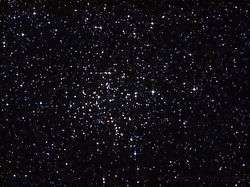M38 | NGC 1912 | Starfish Cluster | Starfish Cluster | 4,200 Light Years Away
Messier 38, also known as the Starfish Cluster, is an open star cluster situated in the constellation Auriga. Discovered by the Italian astronomer Giovanni Batista Hodierna in the 17th century and later independently cataloged by Charles Messier in 1764, this celestial assembly is part of the Milky Way galaxy. Positioned approximately 4,200 light-years away from Earth, Messier 38 is a relatively young cluster, with an estimated age of around 220 million years, and it spans a region of about 25 light-years in diameter.
Comprising over 100 stars, Messier 38 displays a captivating arrangement resembling a starfish, with bright stars forming the cluster’s central body and extended arms. The stars within this open cluster are gravitationally bound, having formed from the same interstellar cloud of gas and dust. Messier 38 is a visually appealing target for amateur astronomers, particularly when observed through binoculars or small telescopes.
Observations of Messier 38 contribute to our understanding of open star clusters, providing insights into the dynamics of stellar systems and the processes involved in the formation and evolution of stars within our galaxy. The study of such stellar groupings helps astronomers unravel the complexities of star birth and the interactions between stars in shared cosmic environments. Messier 38, with its unique appearance and youthful stellar population, adds to the ongoing narrative of star birth and evolution within the intricate tapestry of the cosmos.

